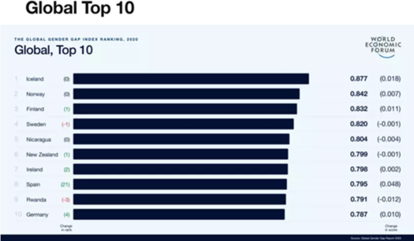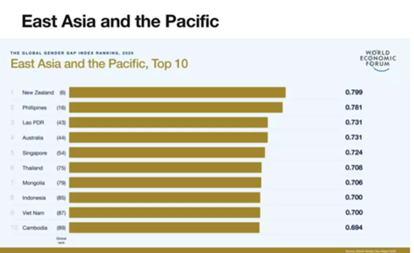Four Women Leaders Shine in Coronavirus Crisis

Four women of the Liberal Party shared their experiences as leaders, from responding to the public-health crisis to their views on traits that matter, in a webinar on “Women Leaders in Politics” last month. Organized by the Friedrich Naumann Foundation (FNF), the webinar coincided with the celebration of National Heroes’ Day in the Philippines, a fitting tribute to the women leaders who are making a difference.
Eight hours before the first lockdown was announced in March, which was to become one of the longest and strictest in the world, Rep. Stella Quimbo, anticipating its devastating impact, filed the first bill in Congress creating an economic stimulus package.
In Dinagat Islands, the northern tip of Mindanao, Gov. Arlene “Kaka” Bag-ao kept the province COVID-free from February to most of August through her early and decisive action, getting together all the mayors to communicate and implement health protocols, organizing the local government agencies to stock up on rice and monitor prices of food in preparation for the long haul, and cooperating with the CARAGA region in shielding the virus from their five provinces.
(It was a national program, the return of residents stranded in Metro Manila—many of whom were not tested—that eventually broke the zero record of Dinagat.)
Similarly, Mayor Trina Firmalo-Fabic has protected her coastal town, Odiongan in the province of Romblon, from Covid. Her secret? First, consistency in implementing rules. No exceptions. Second, clearly communicating these rules and the reasons behind them to the public. Third is transparency: letting the people know of confirmed cases in nearby towns.
Tabaco city in the province of Albay has kept its cases to a minimum—despite its accessibility to Metro Manila, the epicenter of the virus, and the return of more than 4,000 residents who were stranded in various places during the lockdown. Mayor Krisel Lagman-Luistro saw to this through a two-pronged program: creating a communication plan with the key message of preventing the spread of the virus, aided by visuals and infographics; and continuing and enhancing livelihood programs for vulnerable groups. Moreover, as head of the “area development team” composed of six local government units, Lagman-Luistro convened the mayors and came up with a unified plan of action to contain the virus.

In their own words
While Bag-ao, Quimbo, Firmalo-Fabic, and Lagman-Luistro work in different arenas—province, district, town and city—they share common traits and approaches that make them effective leaders. Empathy. Humility. Communication. Collaboration. But they are the first to say that women do not have a monopoly of these qualities and practices.
“I believe in a feminist leadership, creating a more empowering environment for my fellow women, especially those who have experienced inequality and discrimination as women,” Bag-ao, a human rights advocate and lawyer, said. She added that “empathy and caring are not qualities that are exclusive to women. I apply them not only because I am a woman but because I am a human being.”
For Quimbo, former economics professor and mother of four, some traits are linked to being a woman that men can not experience: “There’s one thing that we have monopoly over, which is motherhood. Men can never be mothers. So, there are certain traits related to motherhood like stamina, tolerance for pain that make women better leaders.” For example, she continued, “childbirth is the most painful thing I’ve ever experienced. And the ability to actually deal with pain wires us differently.”
“Women also have predetermined masculine traits such as exuding confidence, being more decisive and appearing to be in control,” Lagman-Luistro, a nurse and former congresswoman, said. “And we can simplify the complex…so that everyone is on the same page. There is such a thing as feminine leadership and I hope these female traits can be imbibed more by male leaders.”
“We’ve been reared to be caring, to have empathy,” Firmalo-Fabic, a sociologist by training, said. “These qualities are becoming strengths for all of us, allowed us to excel in addressing the crisis we are facing. We’ve also felt that we’ve been marginalized at some point and discriminated against. This makes us more humble. We try to put ourselves in other people’s situations. So, we are able to understand the needs of our constituents and become more responsive leaders.”
Global women leaders
The insights and experiences of these four local women leaders are not isolated. They’ve been magnified in the global stage, among female heads of state who have successfully responded to the pandemic.
Bettina Stark-Watzinger, member of parliament and a rising star in German politics, zoomed out to the big picture by showing that political leadership by women during the Covid crisis was “magnificently different.” In her opening remarks, she cited the examples of Prime Minister Jacinta Arden of New Zealand, who was able to bring down the coronavirus cases to a minimum, and the Nordic countries led by women—Iceland, Norway, Finland and Denmark—which have lower death rates than other countries in Europe.
In particular, Stark-Watzinger pointed out the example of Finland where Prime Minister Sanna Marin, the youngest head of government in the world, took an “extraordinary path” in successfully communicating to the people and involving social media influencers with their huge communication networks to help counter fake news on the virus.
While people “love charismatic leaders [who are] charming and entertaining,” she continued, “in contrast, the best leaders are humble maybe even to the point of being a bit boring.” An example, Stark-Watzinger said, is Chancellor Angela Merkel who represents a good leader: “She will never appear in ‘House of Cards,’ a famous political series on bad politics.”

Getting more women in politics
The challenge in the Philippines is to have more women in politics. In Congress, of the 301 members, only 85 are women. And out of the 22 deputy speakers in the House of Representatives, only four are women.
The numbers are similar in the local posts. Of the 1,634 mayors, about one-fourth, 415, are female. Among the governors, 12 are female out of a total of 80.
How can the country increase the number of women in elected posts?
For Quimbo, one big obstacle is teenage pregnancies because this “crushes dreams” of girls to work in meaningful jobs, including aspiring for elected office. This is a pressing national problem crying for attention: The Philippines has one of the highest adolescent birth rates in ASEAN, according to the United Nations Population Fund, with 500 adolescent girls getting pregnant and giving birth every day.
Lagman-Luistro’s advice is to keep the girls in school, invest in their education and start them young in political organizations like the Sangguniang Kabataan, a village-level council which represents the youth. Similarly, Bag-ao advocates giving more educational opportunities to young girls. And for women leaders, part of their mandate is to “inspire other women to take on leadership roles.”
Firmalo-Fabic said a basic thing has to happen first: “Change women’s mindsets, that we can be very good leaders.” Among women, there is still that feeling of inadequacy about being able to lead well. Thus, mentoring by experienced women leaders, she pointed out, would be of much help.
As Wolfgang Heinze, country director for FNF Philippines, aptly said in his closing remarks, these women have exhibited “comprehensive and decisive leadership” and serve as role models for the younger women.
Marites Dañguilan Vitug is an author and editor-at-large of Rappler.
Women in Politics webinar
Philippines Slides in 2020 Global Gender Gap Report
The Philippines has been among the top 10 most gender equal countries in the world for more than a decade, from 2006 to 2019, the World Economic Forum (WEF) annual Global Gender Gap Reports showed.
But the picture changed in 2020 when the Philippines slid to No. 16, with a “widening of the political empowerment gap” which was attributed to the “significantly lower female representation in the Duterte Cabinet” as well as the “low female representation in Congress.”
But there’s still a bright spot. The Philippines is the second most gender equal country in Asia, next to New Zealand.
The WEF Report ranked 153 countries based on four categories: economic participation and opportunity, educational attainment, health and survival, and political empowerment.
Here are the top 10 most gender equal countries in the world and the top 10 in East Asia and the Pacific:

